 |
Black lives matter. This document has an exhaustive list of places you can donate. It’s also got an incredible library of black literature and anti-racist texts. Donate, read, call, and email your representatives. We’re all in this together.
It was all there in about eight minutes. Back in September of 2014, Liverpool were slogging their way through an early-season League Cup match at Anfield. Kolo Toure was involved, same for Simon Mignolet -- and so, too, a 21-year-old Patrick Bamford.
On a half-season loan from Chelsea with Middlesbrough, he’d just made his first start a few days prior and scored his first goal in a win over Brentford. With Liverpool up 2-1 in the 112th minute, on came Bamford. In injury time of extra time, he was fouled in the box by Toure and then proceeded to slot the resulting spot-kick past Mignolet. The game went to penalties, and stayed at penalties forever. Liverpool ultimately advanced, winning 14-13. At one point, 20 penalties in a row were converted, and both keepers scored. Bamford, though, missed the opening penalty for Boro but then converted his second go-round, sandwiched between finishes from Mario Balotelli and Lucas Leiva.
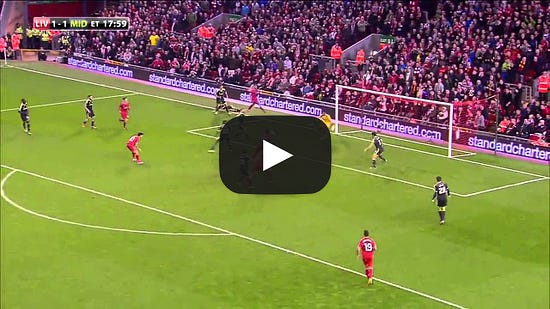
It wasn’t anyone’s takeaway at the time and it wouldn’t be for some while, but the end of the match was something of a snapshot of what would come to define Bamford’s early career: lots of great chances and not as many goals as you’d expect. However, six years later, he’s already been back to Anfield, where he scored again. And through six matches, he’s scored more goals than anyone expected -- and anyone other than Dominic Calvert-Lewin or Son Heung-min.
Will the shots eventually stop going in? Is this the new and improved Patrick Bamford? Or has he just been here all along?
After that Liverpool match, Bamford went on to win the Championship Player of the Season award. In a supposedly grueling, physical, unforgiving competition, this 21 year old scored 17 goals all from open-play and assisted two more. So that’s why Chelsea bought him, huh? But like the majority of Chelsea’s talented loanees over the past decade, Bamford never made it back to Stamford Bridge. The next year he went on loan to Norwich in the Premier League, but only featured for 200-something minutes before personally deciding to terminate his loan mid-season. Second half of the year saw him go to Crystal Palace, who were also in the Premier League and who also refused to give him much playing time. A year after dominating the Championship, all Bamford could get was 362 total minutes in the Premier League for a pair of teams that finished 15th and 19th. No goals for either one.
Next year, it was a loan for Burnley, and to the surprise of approximately no one, that didn’t work out. Bamford was a young prospect who created lots of high-quality shots, while Sean Dyche was a manager with a deep aversion to young players and high-volume chance-creation. Bamford played 39 minutes in the Premier League before once again ending his loan midseason and heading to another Premier League club in January -- this time for good. Just 18 months removed from him dominating England’s second-tier, Chelsea sold Bamford to Middlesbrough for £5.5 million. He scored once and played 287 minutes over the second half of the season as Boro were demoted back to the Championship.
Although it was only about 600-something Premier League minutes over two seasons with an absurd four different clubs, a pattern had started to emerge. Bamford took 17 shots and scored once. One goal on 2.03 expected goals, per Stats Perform. The bigger the circle, the better the chance:
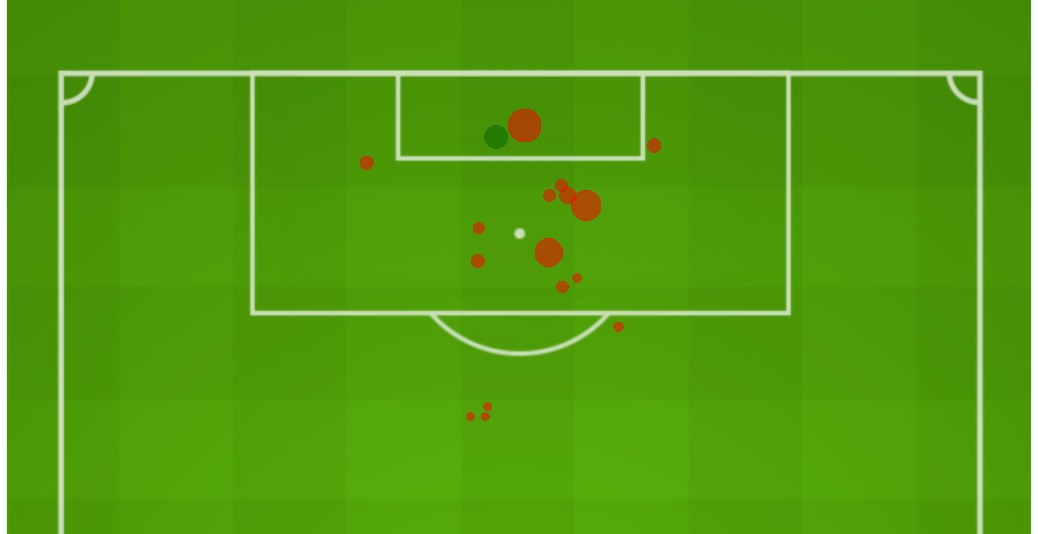 |
Back in the Championship, Bamford was now being coached by the Dychian Tony Pulis -- a stickler for defensive solidity and set-piece execution. Despite being two years older and theoretically two years better, Bamford was unable to match his Player of the Year performance, as he only scored 11 goals in 2017-18. There were some things outside of his control, like playing for Pulis or playing on the wing for a good chunk of the year. But per 90 minutes, his scoring rate only slightly declined from his POTY season: 0.54 to 0.48. Plus, he actually scored more than expected, too, notching 11 goals on 9.01 xG:
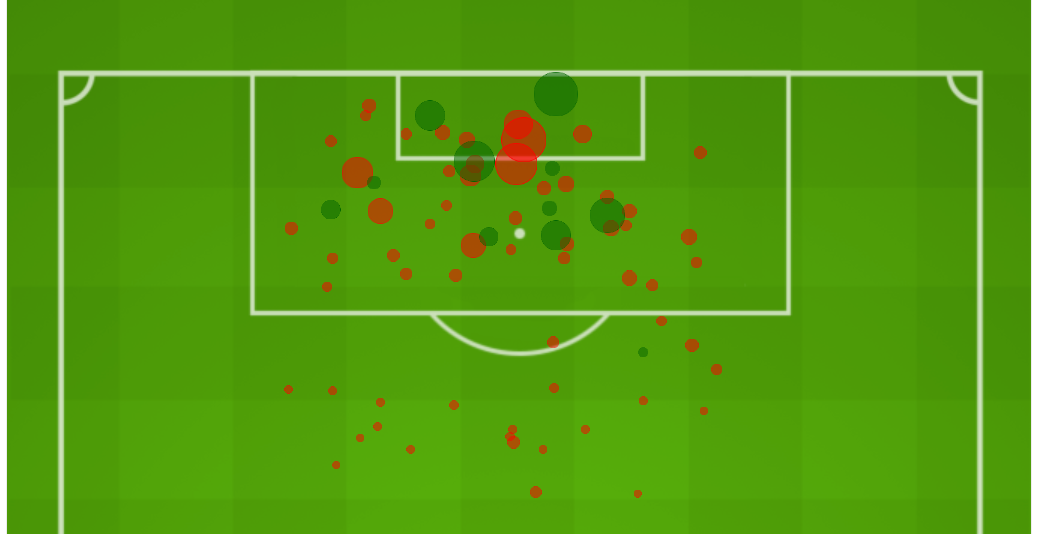 |
That was enough to convince Leeds United buy him from Boro to play for Marcelo Bielsa -- the influential madman (his nickname is literally El Loco) whose ability to build great-chance-generating motion-machines was surpassed only by his ability to burn out himself, his players, his bosses, or all of the above. Under Bielsa, Leeds flourished and so did Bamford -- sort of. Among all players in the Championship and Europe’s Big Five leagues over the past two seasons, only eight guys generated more xG from open-play than Bamford: Robert Lewandowski, Kylian Mbappe, Tammy Abraham, Neil Maupay, Cristiano Ronaldo, Lionel Messi, and Timo Werner. Pretty good company. Except, no one had a wider gap between his goals and his expected goals. Bamford scored 22 open-play goals across two seasons on 35.69 xG. Look at all that red!
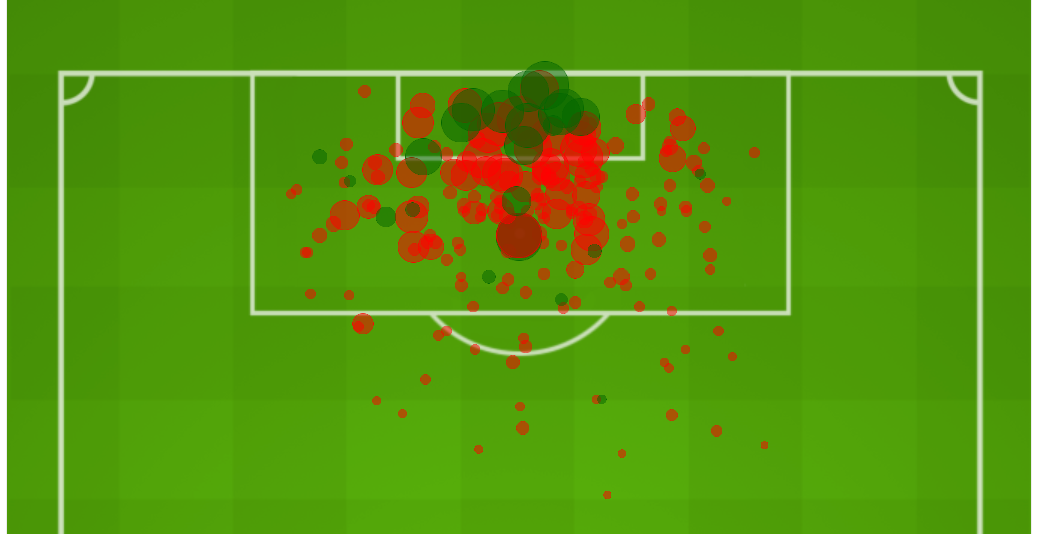 |
Of course, there’s only so much control a player has over the ball when it leaves his foot since there’s a goalkeeper standing in the way, but Bamford hasn’t been too good at that part of the game, either. While traditional xG only calculates a number of factors leading up to right when the shot is taken -- type of pass, body part, and mostly important field location -- xG On Target (xGOT) also looks at where the shot ended up on the goal frame to give a finer picture of the probability of a shot ending up in the back of the net. In other words, if you completely miss the goal frame despite an empty net from three yards away, you get a big ol’ zero. In his two Championship seasons with Leeds, Bamford’s xGOT trailed his xG by 9.99 goals. Put another way: his wayward finishing cost his team an expectation of about 10 goals. That’s the most missed goals by a single player in the same two-year dataset mentioned above.
That brings up two questions: First off, does it even matter? Leeds have rotated in a cast of potential replacements for Bamford over the past two seasons, and none of them have stuck. Over the past two years, Bamford got on the end of an elite-level of quality chances. Given their financial standing, it’s pretty much impossible for Leeds to find a player who’s as good as Bamford at getting on the ball in dangerous areas. Would they really be better off with someone who’s not as good at finding space but converts their chances more frequently? Would that actually lead to Leeds scoring more goals? Even with all those misses, Bamford is still in the top 30 of the xGOT chart -- right behind Sergio Aguero and right ahead of Romelu Lukaku.
The ability to find lots of good shots is the main skill that defines a good goal-scorer. Finishing ability only helps on the margins. As Bobby Gardiner found back in 2018 in a piece I worked on with him for The Ringer: “Of all players to have scored more than five open-play goals in Europe’s biggest five competitions last year, the average xG added from their shot quality is just 8 percent.” Take even the best finisher, Messi, who added 13.74 to his xG with his shot placement over the previous two seasons. (No one else was above 8.63; the guy still is not human.) His xG tally of 43.88 rises to an xGOT of 57.62; that’s only a 24-percent increase. In other words, 75-percent of Messi’s goal-scoring can be explained by things other than how good he is at kicking a soccer ball.
And now, for the second question: If someone was a below-average finisher in the past, does that mean he will continue to be a below-average finisher in the future? If you cut bait on Bamford, you’re essentially eliminating for the possibility that he either A) gets lucky for a year or two and starts scoring most of those chances, or B) was getting unlucky (or could get better) and is bound to start converting his chances at something closer to an average rate. Bielsa and Co. held firm, and at least thus far, they’ve been rewarded by both A and B.

“Bamford is already close to an average finisher with his head for the Premier League, but he's been below par with his feet for some time,” said Dan Altman, founder of the analytics site Smarterscout. Their ratings, which work similarly to an Elo-rating system, peg Bamford currently as a 16th-percentile finisher with his feet and 43rd with his head. “So far this season, he's scored about three goals more than a generic player would have been expected to score from the same chances with his feet,” he said. “That's not controlling for the quality of goalkeepers he faced, but it's obviously going to boost his rating somewhat in the short term.”
Through six games as of Monday afternoon, Bamford is fourth in the Premier League in shots -- behind Mohamed Salah, Harry Kane, and Aleksandar Mitrovic. He’s fourth in xG -- behind DCL, Sadio Mane, and Kane. And he’s second in xGOT -- behind only Son Heung-min. Only Son, Danny Ings, and Alexandre Lacazette have added more goals with their finishing. Check him out, in red:
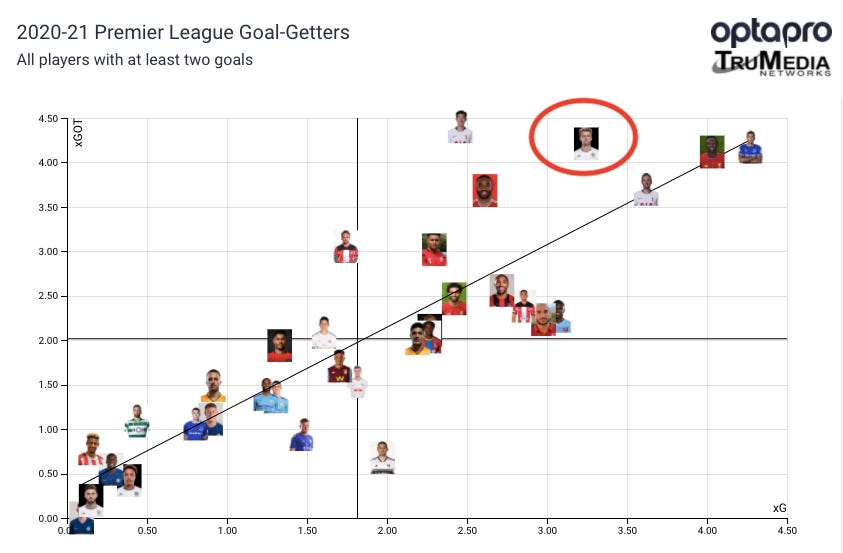 |
And so, Bamford is getting great chances (high xG), finishing them successfully (higher xGOT), and scoring them impressively (even higher goal total). Will it continue? The finishing struggles with Leeds in the Championship are based on only 211 total shots, which really isn’t close to enough shots to make any kind of definitive statement about Bamford’s ability to shoot a soccer ball. Even if you flip a coin 211 times, you’re probably not gonna get an accurate picture of how likely it is to land heads or tails. Same goes for the 23 shots he’s taken this season. The most likely outcome is still a pretty great outcome for everyone: he finishes somewhere between what he’s doing now and what he’s done in the past.
One of the hardest things to do in sports is to not get distracted by all the factors that are out of your control. For a manager, that might mean sticking with a plan that produces impressive performances but a run of unsatisfactory results. For a player, it means not getting discouraged when the bounces don’t go your way, even if it’s happening over and over and over again. Both Leeds and Bamford bet on the things they could control, and although the newly-promoted side are two points out of the Champions League places and their striker is in the thick of the golden boot race, that part of the game remains the same as it’s always been.
